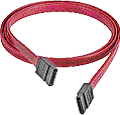Integrated Drive Electronics (IDE)


An IDE interface is an interface for mass storage devices, in which the controller is integrated into the disk or CD ROM drive. Although it really refers to a general technology, most people use the term to refer the ATA specification, which uses IDE technology. Cables for IDE (original version) usually have all connectors black and crimped on a 40-conductor ribbon cable. Click Here to see our selection of IDE cables (some Ultra ATA cables will also appear in this list). Jumper settings on the drive determine weather the drive is a Master or a Slave.
Advanced Technology Attachment (ATA)


Advanced Technology Attachment Packet Interface (ATAPI)


ATA is a disk drive implementation that integrates the controller on the disk drive itself.
There are several versions of ATA, all developed by the Small Form Factor (SFF) Committee:
- ATA: Known also as IDE, supports one or two hard drives, a 16-bit interface and PIO modes 0, 1 and 2.
- ATA-2: Supports faster PIO modes (3 and 4) and multiword DMA modes (1 and 2). Also supports logical block addressing (LBA) and block transfers. ATA-2 is marketed as Fast ATA and Enhanced IDE (EIDE).
- ATA-3: Minor revision to ATA-2.
- Ultra-ATA: Also called Ultra-DMA, ATA-33, and DMA-33, supports multiword DMA mode 3 running at 33 MBps.
- ATA/66: A version of ATA proposed by Quantum Corporation, and supported by Intel, that doubles ATA’s throughput to 66 MBps.
- ATA/100: An updated version of ATA/66 that increases data transfer rates to 100 MBps.
ATA-2 and above will require a higher-grade cable. Ultra ATA cables usually have a Black, Gray and Blue connector and 80 conductors, half of which are used to reduce crosstalk by putting a ground on every other wire. The connector colors designate where they’re connected. The Blue is for the PCs Motherboard (or IDE controller). The Black is for the Master drive while the Gray is for the slave drive. Master and Slave cannot be determined by jumper settings but instead is determined by which color you plug into that drive. Click here to see our selection of Ultra ATA cables
ATA also is called Parallel ATA. Contrast with Serial ATA.


Often abbreviated SATA or S-ATA, an evolution of the Parallel ATA physical storage interface. Serial ATA is a serial link — a single cable with a minimum of four wires creates a point-to-point connection between devices. Transfer rates for Serial ATA begin at 150 MBps. One of the main design advantages of Serial ATA is that the thinner serial cables facilitate more efficient airflow inside a form factor and also allow for smaller chassis designs. In contrast, IDE cables used in parallel ATA systems are bulkier than Serial ATA cables and can only extend to 40cm. Serial ATA supports all ATA and ATAPI devices. SATA cables support a single drive each. The Motherboard or controller needs a SATA port for each drive. Click Here to see our complete list of Ultra ATA cables including Serial ATA cables.





